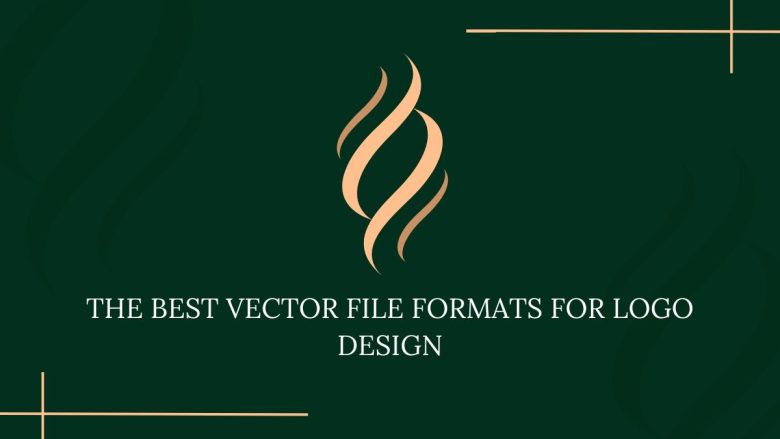
In the world of logo design, vector files reign supreme. Raster images are made up of pixels. In contrast, vector images are created using math. This allows them to be scaled infinitely without losing quality. It makes them ideal for logos. You may be designing a logo for a business, a personal project, or a client. In this case, knowing the various vector file formats and their uses is key. In this post, we’ll explore the top vector file formats for logos. We’ll cover their advantages and when to use each one.
1. SVG (Scalable Vector Graphics)
SVG is a widely used vector format. It’s based on XML (Extensible Markup Language). It was developed by the World Wide Web Consortium (W3C) and is supported by most modern web browsers.
Advantages:
- Scalability: SVG files can be scaled to any size without losing quality, making them perfect for responsive web design.
- Editability: SVG files can be edited with any text editor or vector graphics editor, such as Adobe Illustrator or Inkscape.
- Interactivity: SVG supports interactivity and animation, allowing designers to create dynamic, engaging logos.
- Web-friendly: SVG files are lightweight and can be compressed, which helps in faster web page loading times.
When to Use:
- Web Design: SVG is ideal for logos that will be used on websites, as it ensures crisp, clear images on all devices.
- Responsive Design: For logos that need to adapt to different screen sizes, SVG is the best choice.
- Interactive Logos: If your logo requires animation or interactivity, SVG provides the necessary features.
2. EPS (Encapsulated PostScript)
Overview: EPS is a vector file format that was developed by Adobe. It’s widely used in pro printing and publishing. This is due to its versatility and compatibility with design software.
Advantages:
- Compatibility: EPS files can be opened and edited with many vector graphic programs, including Adobe Illustrator, CorelDRAW, and even some raster graphic programs like Adobe Photoshop.
- Print Quality: EPS files maintain high resolution and quality when printed, making them ideal for professional print projects.
- Transparency: EPS supports transparency, which is useful for integrating logos seamlessly into different backgrounds.
When to Use:
- Print Media: EPS is the go-to format for logos that will be printed on business cards, brochures, flyers, and other printed materials.
- Professional Design: For high-quality, professional logo design work, EPS is a reliable and versatile choice.
- Branding: If you need a logo that will be used across various mediums and formats, EPS ensures consistent quality.
3. AI (Adobe Illustrator)
Overview: AI is the native file format for Adobe Illustrator, one of the most popular vector graphic design tools. It is specifically designed for creating and editing vector graphics.
Advantages:
- Editability: AI files can be easily edited in Adobe Illustrator, offering a wide range of tools and features for precise logo design.
- Layer Support: AI files support layers, which allows designers to work on different elements of the logo separately and efficiently.
- Integration: AI integrates seamlessly with other Adobe Creative Cloud applications, such as Photoshop, InDesign, and After Effects.
When to Use:
- Design Process: Use AI files during the design process for easy editing and refining of your logo.
- Collaboration: If you’re working with other designers or need to share your work with clients, AI files ensure that all elements of the logo are editable.
- Complex Designs: For logos that require intricate details and multiple elements, AI provides the necessary tools and flexibility.
4. PDF (Portable Document Format)
Overview: PDF is a versatile file format developed by Adobe. It’s primarily known for document sharing. But, PDFs can also have vector graphics. This makes them useful for logo design.
Advantages:
- Universal Compatibility: PDF files can be opened and viewed on almost any device, ensuring that your logo can be easily shared and accessed.
- Security: PDF files can be password-protected and encrypted, offering a secure way to share logo designs with clients and stakeholders.
- Print Quality: PDFs maintain high resolution and quality for printing, similar to EPS files.
When to Use:
- Client Proofs: Use PDF files to share logo proofs with clients, as they can be easily viewed on any device.
- Final Deliverables: For delivering the final logo design to clients, PDF ensures that the logo is accessible and retains its quality.
- Multi-Purpose: If you need a versatile file format that can handle both vector graphics and text, PDF is a solid choice.
5. CDR (CorelDRAW)
CDR is the native file format for CorelDRAW. It is a popular software for vector graphic design. It’s widely used in various industries, including graphic design, marketing, and sign making.
Advantages:
- Compatibility: CDR files can be opened and edited in CorelDRAW, which offers a range of powerful design tools.
- Editability: Similar to AI files, CDR files allow for easy editing and manipulation of vector graphics.
- Industry Use: CorelDRAW is commonly used in industries that require detailed and precise vector graphics, making CDR files a valuable asset.
When to Use:
- CorelDRAW Users: If you or your team primarily use CorelDRAW, CDR is the best format for your logo designs.
- Detailed Designs: For logos that require intricate details and precision, CDR provides the necessary tools.
- Industry-Specific Needs: If your logo design work is focused on industries like sign making or embroidery, CDR is a widely accepted format.
6. DXF (Drawing Exchange Format)
DXF is a vector file format. Autodesk developed it for data interoperability between AutoCAD and other programs. It’s mainly used for CAD (Computer-Aided Design). But, it can also be used for logo design.
Advantages:
- Interoperability: DXF files can be imported and edited in various CAD and vector graphic programs.
- Precision: DXF files support high levels of precision, which is useful for logos that require exact measurements and specifications.
- 3D Compatibility: DXF files can contain 3D vector data, which can be beneficial for certain types of logo designs.
When to Use:
- CAD Integration: If your logo design needs to be integrated into CAD projects or requires precise measurements, DXF is the right choice.
- Architectural and Engineering Firms: For logos used by companies in architecture or engineering, DXF ensures compatibility with their existing software.
- Technical Designs: For logos that require technical precision and detail, DXF offers the necessary features.
Conclusion
Choosing the right vector file format for your logo design depends on your needs. It also depends on how you will use the logo. SVG is great for web logos. EPS is ideal for print. AI is good for design. PDF is versatile. CDR is for CorelDRAW users. DXF is for CAD. You can ensure that your logo designs are high-quality, versatile, and ready for any use. You can do this by understanding the benefits and best uses of each format.
When working with clients, it’s also good to provide the logo in many formats. This ensures that they can use it across platforms and mediums. This shows your professionalism. It also keeps the client’s brand consistent and effective.
In the end, learning these formats will improve how you design logos. They’ll help you make stunning, scalable logos. These logos will stand out in any context.


